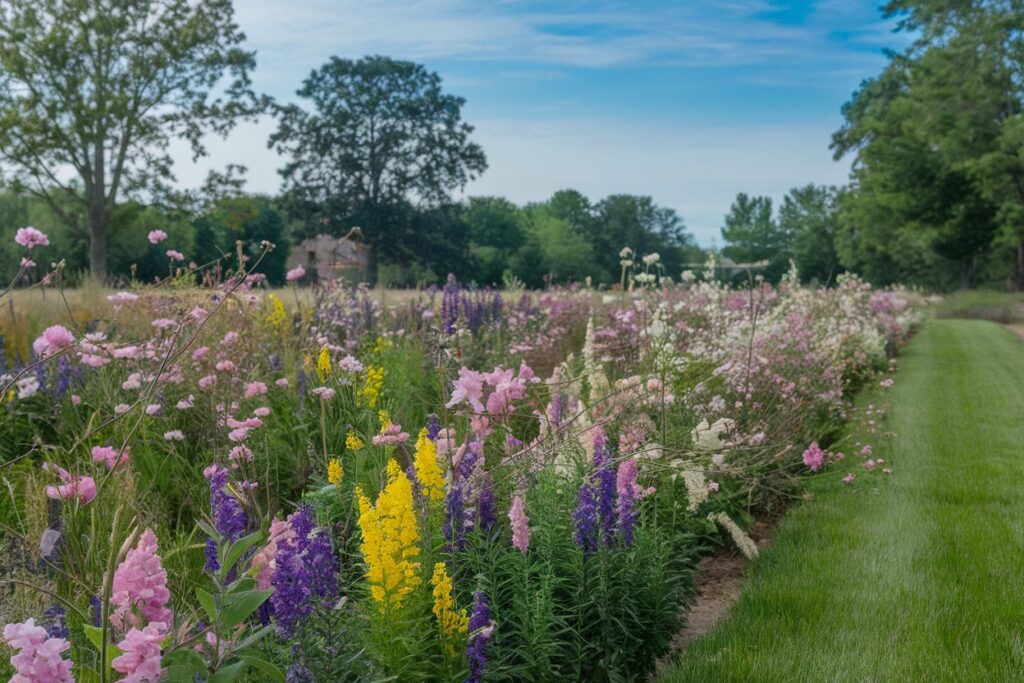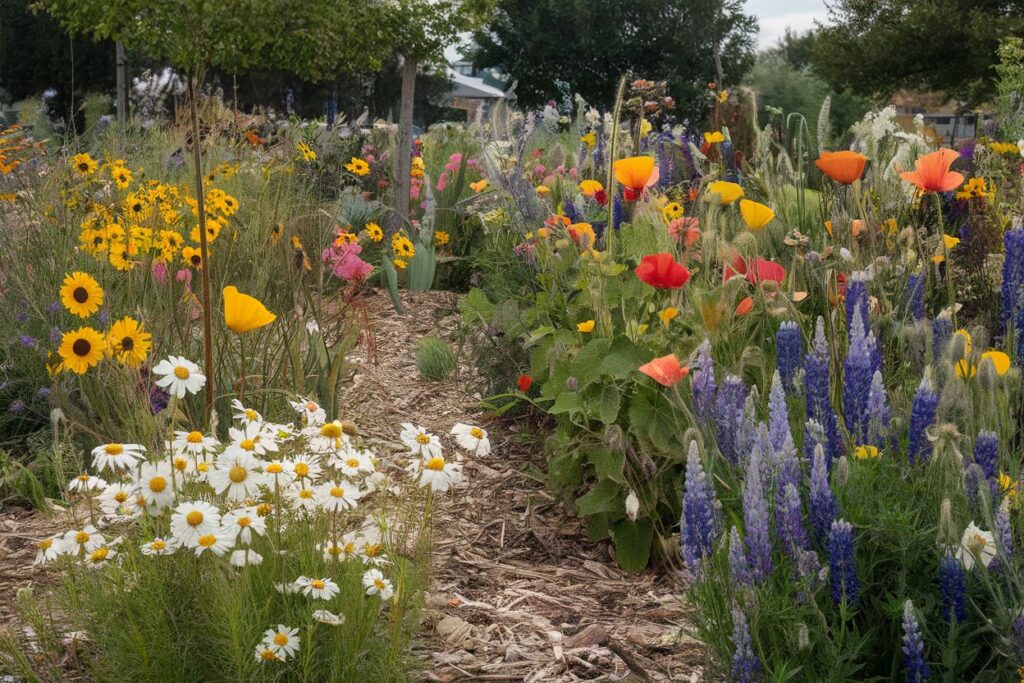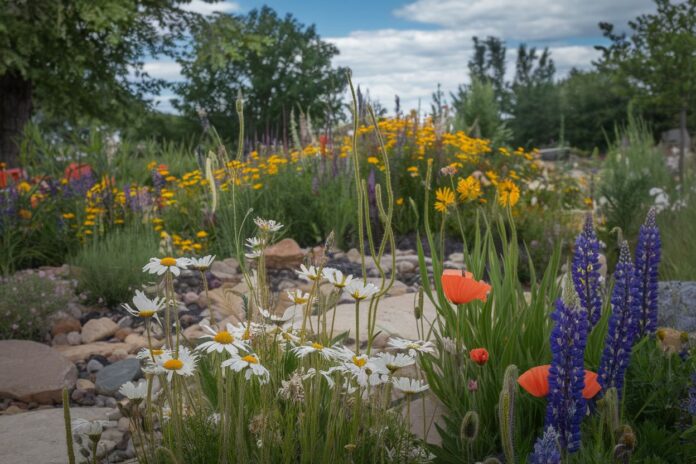Creating a wildflower meadow without tilling is a green way to garden. It keeps the soil healthy and boosts biodiversity. Native wildflowers can make your outdoor area beautiful without harming the environment.
To make a meadow, you need a good plan and knowledge of your area’s plants. No-till gardening helps protect the soil and supports local wildlife. It’s a great way to create a beautiful, easy-to-care-for garden.
Using these new gardening methods, you can make a wildflower garden that helps the planet. You’ll need to pick the right spot, prepare it well, and spread the seeds carefully. This way, you won’t harm the soil.
This guide will show you how to start a wildflower meadow. We’ll focus on green gardening that respects nature’s balance.
Benefits of No-Till Wildflower Planting
No-till wildflower planting changes how we garden. It brings many benefits that go beyond old ways of gardening. It makes your backyard a sustainable ecosystem.
Soil Structure Preservation
No-till gardening keeps the soil’s delicate ecosystem safe. Soil health stays good, with microorganisms and roots intact. This helps roots grow deep and keeps nutrients flowing, unlike traditional gardening.
Environmental Impact Benefits
No-till gardening is kind to the environment. It helps capture more carbon dioxide, which is good for the planet. It also stops soil erosion and saves water by keeping soil moist.
“Nature’s most sophisticated gardens grow without human intervention” – Ecological Restoration Expert
Cost and Time Savings
No-till gardening saves time and money. It doesn’t need a lot of preparation, making planting quick and easy. This means less work and lower costs, making gardening more sustainable and affordable.
Best Seasons and Climate Conditions for Wildflower Planting

Timing is key when planting wildflowers in spring or fall. Each area has its own weather that affects how seeds grow. Choosing the right native plants is crucial for a healthy wildflower garden.
In places with mild winters, spring is the best time to plant. Seeds are sown from late February to early May. This is when the soil is warm enough and frost is less likely.
Frost seeding is great for colder areas. It lets seeds germinate naturally when the weather gets right.
Fall sowing is also a good choice. In cooler autumns, seeds can survive the winter and start growing in spring. This method uses the natural moisture and protects seeds with mulch.
It’s important to consider your area’s climate. The Southwest is different from the Northeast. Choose plants that fit your local weather for better growth and less care.
Site Preparation and Weed Management
Starting a wildflower garden needs careful site preparation. It’s important to know your landscape and use organic weed control. This keeps the soil healthy and the ecosystem balanced.
Natural Weed Suppression Methods
Organic weed control begins with prevention. Mulching stops weeds and keeps the soil moist. Solarization uses the sun’s heat to kill weeds, preparing the area for wildflowers.
“The key to successful weed management is understanding your soil’s ecosystem and working with nature, not against it.” – Native Plant Restoration Expert
Soil Testing and Amendment
Do a soil test before planting to check nutrients and pH. Knowing these helps create the best conditions for wildflowers. Organic amendments can adjust pH and improve soil, helping plants grow well.
Clearing Existing Vegetation
Clear the area with cover crops or by hand. Cover crops like clover or rye fight weeds and enrich the soil. This method avoids harmful chemicals and promotes a healthy garden.
How to Plant Wildflowers Using No-Till Methods

Planting wildflowers without harming the soil is key. Broadcast seeding is a top choice for this. It helps create beautiful native meadows with little soil disturbance.
Seed balls are a creative way to plant without tilling. They are made of clay and seeds. You can just throw them on the ground. This method supports local wildlife and pollinators with the right seed mixes.
“Nature’s most elegant solutions often require the least intervention.” – Ecological Restoration Expert
Hydroseeding is another no-till method for big areas. It sprays seeds, mulch, and nutrients on the ground. The right amount of seeds per square foot is important for growth, usually 10-20 seeds.
For no-till wildflower planting to work, consider these:
– Choose native seed mixes
– Know your local climate
– Make sure seeds touch the soil
– Watch how they grow at first
Using these gentle methods, gardeners can make stunning wildflower areas. They also keep the soil and ecosystems healthy.
Essential Maintenance and Watering Guidelines
Creating a thriving wildflower meadow needs careful care and attention. It’s important to understand the needs of your plants and use smart watering methods. These steps help keep your plants healthy for a long time.
Wildflower gardens need special care that’s different from regular landscaping. By using the right maintenance, you can have beautiful, low-maintenance native plants.
Seasonal Water Management
Each drought-tolerant plant needs different amounts of water at different times. When they’re new, they need steady moisture to grow roots. In summer, they need less water but deeper watering to grow strong roots. Spring and fall need very little extra water.
Natural Pest Control Strategies
Attracting good bugs is key to keeping your garden balanced. Wildflowers naturally draw in pollinators and bugs that eat pests. By planting many types of plants, you create a garden that takes care of itself and needs less chemicals.
Long-Term Care Techniques
Good mowing is crucial for your wildflower meadow. Use smart reseeding to keep plants thick and weeds out. Mowing in late winter or early spring helps get rid of old plants and encourages new growth.
Final Thoughts
No-till wildflower planting is a game-changer for gardening. It protects the soil and helps local ecosystems. This method makes it easy to create beautiful spaces that need little care.
This approach boosts ecosystem services. It lets native plants grow strong, helping local wildlife. These gardens are more than pretty; they’re key to saving our planet’s biodiversity.
Using no-till wildflower methods lets people make a big difference. Every native plant adds to a strong, self-sustaining garden. These gardens heal and protect our environment.
Gardeners who try these new ways can turn their yards into living wonders. These spaces support wildlife, use less resources, and are stunning. They also need very little upkeep.











